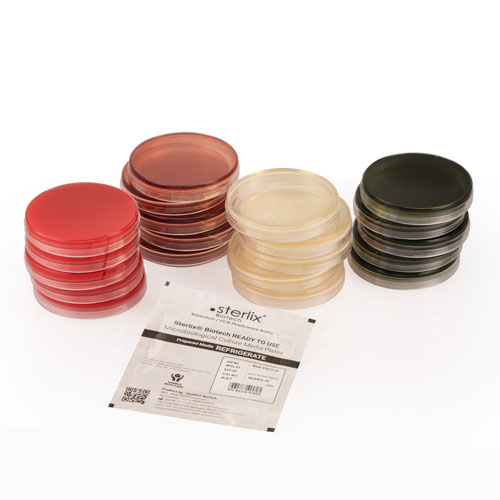STERLIX® Simmons Citrate Ready To Use Agar Slant
Product Details
Simmons Citrate Agar slant is a specialized culture medium used for the detection and differentiation of microorganisms based on their ability to utilize citrate as the sole carbon source. It is particularly used for the identification of bacteria belonging to the Enterobacteriaceae family.
Simmons Citrate Agar slant is a specialized culture medium used for the detection and differentiation of microorganisms based on their ability to utilize citrate as the sole carbon source. It is particularly used for the identification of bacteria belonging to the Enterobacteriaceae family.
The composition of Simmons Citrate Agar slant typically includes:
Sodium Citrate: Sodium citrate serves as the sole carbon source in the medium. Bacteria that possess the enzyme citrate permease can transport and utilize citrate as a carbon and energy source.
Ammonium Dihydrogen Phosphate: Ammonium dihydrogen phosphate acts as a nitrogen source in the medium, supporting bacterial growth.
Bromothymol Blue: Bromothymol blue is a pH indicator that turns from green to blue when the pH rises above a certain level, indicating the utilization of citrate.
Agar: Agar is added as a solidifying agent, providing a solid surface for bacterial growth and colony formation.
To perform the test, a bacterial culture is streaked onto the slant surface of Simmons Citrate Agar. If the bacterium can utilize citrate, it will grow on the slant, and over time, the pH of the medium will increase, causing a color change from green to blue due to the indicator. This indicates a positive result for citrate utilization. Bacteria that cannot utilize citrate will not grow on the slant, and the medium will remain green.
Simmons Citrate Agar slant is commonly used in clinical microbiology laboratories for the identification and differentiation of bacteria, especially within the Enterobacteriaceae family. It helps distinguish between different species or genera based on their ability to utilize citrate as a carbon source. This test is particularly useful in differentiating between members of the Enterobacteriaceae family, such as Escherichia coli (negative) and Citrobacter freundii (positive).
Simmons Citrate Agar slant is a specialized culture medium used for the detection and differentiation of microorganisms based on their ability to utilize citrate as the sole carbon source. It is particularly used for the identification of bacteria belonging to the Enterobacteriaceae family.
The composition of Simmons Citrate Agar slant typically includes:
Sodium Citrate: Sodium citrate serves as the sole carbon source in the medium. Bacteria that possess the enzyme citrate permease can transport and utilize citrate as a carbon and energy source.
Ammonium Dihydrogen Phosphate: Ammonium dihydrogen phosphate acts as a nitrogen source in the medium, supporting bacterial growth.
Bromothymol Blue: Bromothymol blue is a pH indicator that turns from green to blue when the pH rises above a certain level, indicating the utilization of citrate.
Agar: Agar is added as a solidifying agent, providing a solid surface for bacterial growth and colony formation.
To perform the test, a bacterial culture is streaked onto the slant surface of Simmons Citrate Agar. If the bacterium can utilize citrate, it will grow on the slant, and over time, the pH of the medium will increase, causing a color change from green to blue due to the indicator. This indicates a positive result for citrate utilization. Bacteria that cannot utilize citrate will not grow on the slant, and the medium will remain green.
Simmons Citrate Agar slant is commonly used in clinical microbiology laboratories for the identification and differentiation of bacteria, especially within the Enterobacteriaceae family. It helps distinguish between different species or genera based on their ability to utilize citrate as a carbon source. This test is particularly useful in differentiating between members of the Enterobacteriaceae family, such as Escherichia coli (negative) and Citrobacter freundii (positive).

